GIA Diamond Reports
 For a diamond lab report, GIA is the recognized authority. But wait—GIA has several "diamond certs," several lab reports with different names. What's that about?
For a diamond lab report, GIA is the recognized authority. But wait—GIA has several "diamond certs," several lab reports with different names. What's that about?
GIA produces—take a breath—9 different diamond reports. Some reports are only for mined diamonds, some are only for lab-made diamonds, some are "paperless" (online) reports, some are for colored diamonds, some are only for stones in a particular size range. The different reports have different prices.
The difference between them is in how complete the information is. Here's how it all breaks down.
GIA tests all stones to determine whether they are natural (mined) or synthetic (lab-grown). For lab-grown diamonds, the lab issues a Synthetic Diamond Report, so there is never any confusion. The lab also tests every submitted diamond for color and clarity treatments.
4 Reports for natural (mined) diamonds
| Paper documents | Online reports |
|---|---|
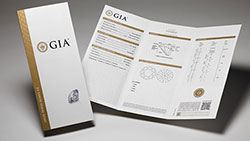 Diamond Grading Report |
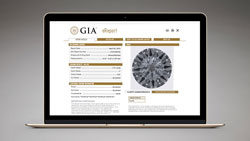 Diamond eReport Diamond eReport |
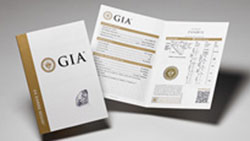 Diamond Dossier® Diamond Dossier® |
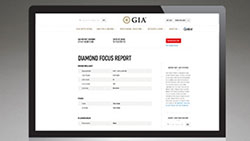 Diamond Focus™ Report Diamond Focus™ Report |
Diamond Grading Report – Insurers: this is the one to get
The Diamond Grading Report is GIA's most complete report. We'll look at its contents in some detail, and then briefly compare the other reports to this one.
This report is available on diamonds of 0.15+ carats—that is, virtually any diamond. It includes:
Carat weight
Stones are examined unmounted, so there's no approximating the weight.
Color grade
Clarity grade
Cut grade
This is only for round brilliant diamonds, for which the most attractive proportions have been established. A diagram gives the actual proportions of the diamond.
GIA grading scales for color, clarity and cut
Showing the grading scales allows the customer/insurer to see what the grade means. Other labs may use grading systems that are not widely recognized, so their grades are not useful. Even those that do use the GIA system may not show the grading scales.
Plotted clarity diagram
A diagram shows what kinds of inclusions are in the stone and where they are located.
Shape and cutting style
Measurements
Polish & symmetry
Fluorescence
Laser inscription - optional
Inscribing the stone with the GIA report number is useful for identifying the stone, but with this report the customer must pay extra.
Comments
If treatments are detected, that info is given under "Comments." It's unfortunate that this crucial information is tucked away here at the end, where it could go unnoticed, because color and clarity treatments can significantly lower the value of a diamond.
Diamond Dossier®
This report, with its fancy name and lower cost, is available only for diamonds of 0.15-1.99 carats. It carries most of the above information.
But it does not have a plotted clarity diagram. A plotted diagram is important because the location of an inclusion can seriously affect valuation. A flaw on the diamond's table, the top of the stone, is more serious than a deeper inclusion.
The Diamond Dossier, however, includes laser inscription of the GIA report number at no charge.
Diamond eReport
This is a "paperless" report presented online. It is for 0.15-2.99 carat diamonds and carries much the same info as the Diamond Grading Report.
It does not have the clarity diagram, though clarity characteristics are listed.
It does include a digital photograph of the stone. As you hover your cursor over the image, the stone is enlarged so you can see any inclusions. Someone knowledgeable about gems would be able to tell what kind of inclusions they are and where they are located.
The online report could be printed out, but the image accessibility would be lost. Since location of the inclusions could not be printed, we recommend that insurers require a Diamond Grading Report.
Diamond Focus Report -- Not acceptable for insurers
The Diamond Focus Report is another online report that could be printed out and submitted to an insurer. This report, for diamonds no larger than 0.39 carats, lacks important information.
It does not havea clarity diagram or cut proportions. Clarity and cut are essential for valuing a diamond. Since this report lacks both, we warn insurers not to regard a printout of this report as sufficient basis for coverage.
2 Colored Diamond Reports
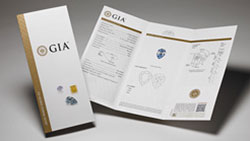 Colored Diamond Grading Colored Diamond Grading Report |
 Colored Diamond Identification and Origin Report Colored Diamond Identification and Origin Report |
Colored Diamond Grading Report
This report covers much the same information as the Diamond Grading Report for colorless diamonds, except:
It does not have cut grade (although cut is not as important for colored stones as for colorless diamonds)
The color grade is in words; the sample report describes color as Fancy Intense Blue. (This descriptive system is different from the tone-saturation-hue grading system GIA developed for colored gems, such as sapphire and emerald.) A diagram shows the color relationships.
It does include color origin and color distribution. "Natural" means the stone has not been color-treated. If the report says "treated color," a Diamond Color Treatment letter can be requested (for an additional fee) to provide the specific color treatment method.
Laser inscription and a color photo of the gem are optional, requiring additional fees.
Colored Diamond Identification and Origin Report -- Not acceptable for insurers
This report, with its long title, actually gives less information than the one described above. Here there is only carat weight, stone measurements, color, and the determination as to color treatment.
It does not have a clarity grade or a plotted clarity diagram, and does not mention polish, symmetry or fluorescence.
Laser description and color image of the stone are optional.
This report is available for mounted, as well as unmounted, stones.
Important Note: "Origin" in the name of this report refers to origin of the stone's color (this is, natural or the result of color treatment). In GIA's reports for other colored stones, such as ruby and sapphire, "origin" refers to the geographic origin of the stone. (For other colored gems, the location where the stone was mined may affect its qualities and value—for example, Burma ruby. For diamonds, whether colored or colorless, geographic origin does not affect the quality of the gem.)
3 reports on synthetic (lab-made) diamonds
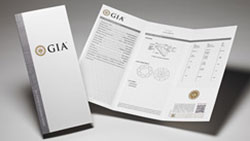 Synthetic Diamond Grading Synthetic Diamond Grading Report |
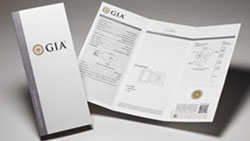 Synthetic Colored Diamond Grading Synthetic Colored Diamond Grading Report |
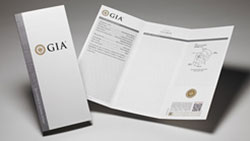 Synthetic Colored Diamond Identification Report Synthetic Colored Diamond Identification Report |
All three reports specifically identify the stone as Laboratory Grown.
In addition, the Comments area carries the sentence: "This is a man-made diamond and has been produced in a laboratory."
Synthetic Diamond Grading Report
(For colorless or near-colorless stones)
This report covers basically the same ground as the Diamond Grading Report for natural diamonds, described above, with the following exceptions:
Color and clarity of synthetic diamonds are described with real words (i.e., colorless, flawless), rather than the letter and number systems GIA developed for mined diamonds. The grading scales are shown in the report.
Synthetic Colored Diamond Grading Report
(for fancy colored synthetic diamonds)
The report is similar to the Colored Diamond Grading Report for mined diamonds, with the following exceptions:
For color grade, the report gives what GIA calls a "general color description," such as Fancy Yellow.
Clarity is described in words, such as flawless, very slightly included, etc. The grading scale is shown on the report.
Synthetic Colored Diamond Identification Report --Not acceptable for insurers
The Identification Report is much briefer, listing shape, measurements, carat weight, general color description, inscriptions, and the comment about the stone being lab-made.
It does not give clarity grade or a clarity diagram, cut grade, florescence, polish or symmetry
This report is available for mounted, as well as unmounted, stones. For mounted stones, it does not give carat weight.
2 Colored Stone Reports
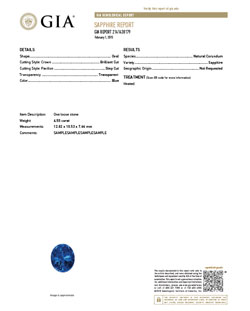 Colored Stone Identification Report |
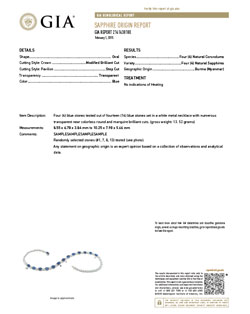 Colored Stone Identification & Origin Report |
The reports are basically the same except:
Colored Stone Identification Report
Will be done on "any material, any size"
Does not give geographic origin
Colored Stone Identification and Origin Report
Will be done only on ruby, sapphire, emerald, Paraiba tourmaline, and red spinel
Gives geographical origin "if origin can be determined and is applicable to the gemstone type"
Information and photos of reports in this issue are taken from the GIA website, which has detailed descriptions of their lab reports and services, as well as their fee structure.
FOR AGENTS & UNDERWRITERS
GIA's reports for lab-made stones identify them in 3 places as synthetic, lab-grown or man-made. Other labs—and certainly many appraisals—may not be this careful. Lab-made diamonds have a significantly lower value than mined stones of the same quality.
You can check the validity of any GIA report you receive by going to the GIA site. GIA may change the appearance of their lab reports from time to time, but the report number is what you need.
For lab reports from other respected labs, follow these links:
AGS Report Verification
GCAL Certificate Search
AGL
Gübelin Report Verification
The market is flooded with bogus certificates from less reliable labs and even from non-existent labs, with just a name on the doc but no address and no reputation. Be especially wary of certificates that have a valuation, as these are basically sales tools supplied by the seller. They often have exaggerated quality descriptions and inflated valuations.
FOR ADJUSTERS
If you are dealing with questionable appraisals or lab reports, use Jewelry Appraisal & Claim Evaluation JISO (formerly ACORD) 18 to organize descriptive data from the documents available.
For damage claims, always have the jewelry inspected in a gem lab by a trained gemologist (GG, FGA+ or equivalent), who is hired by the insurer, to verify the quality of the gem.
©2000-2025, JCRS Inland Marine Solutions, Inc. All Rights Reserved. www.jcrs.com

